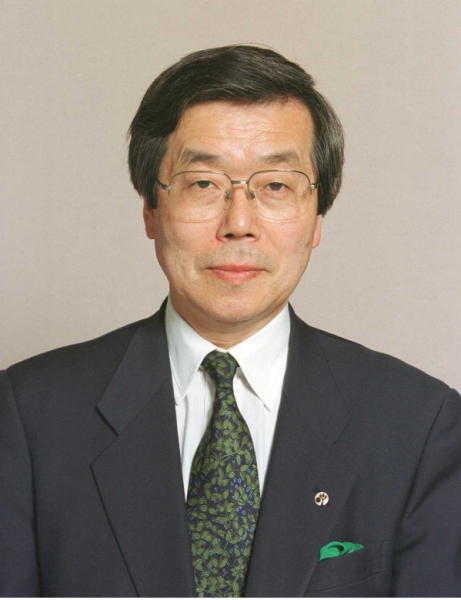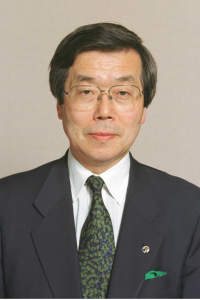Reversing the Disappearance of the Regions – Learning from Success Stories Local (L) Prescriptions Differ from Global (G) OnesThe Key to Revival is to Create Clusters of Corporations and Towns
The Dichotomy of Global and Local Economies
As the premise for understanding my unique prescription for what should be done to revive the regions, I would like to point out that the Japanese economy is divided into a global (G) sphere and a local (L) sphere.
The players in the global economic sphere are the big corporations centered on the manufacturing industry and the IT industry. They compete with the rest of the world; to use a sporting metaphor, they compete at the Olympic level.

TOYAMA Kazuhiko,
Representative Director and CEO, Industrial Growth Platform, Inc.
On the other hand, the actors in the local economic sphere are community-based small and medium-sized companies in retail and wholesale, transportation, distribution, social welfare, day care, nursing and medical care. The focus is on customer-facing services, but since the locality imposes limitations on location, the sporting metaphor would be a prefectural tournament.
In the global sphere, perfect competition modeled on market principles is evolving. For economies of scale to function, companies compete for a share of the world market. Market principles do not apply to the local sphere where competition is imperfect because companies do not move localities to compete with each other. A bus company in Tohoku does not compete with a bus company in Shikoku. The key is the degree of closeness to the community and the density. The required strategy is to gain competitive strength by concentrating the number of outlets locally. Seven & i Holdings and Aeon are well-known retailers, but, in actual fact, the two companies only account for 8 or 9% of the retail industry in Japan, even when you add up their respective shares of the market. The local sphere is a decentralized economy. In the global sphere, oligopolies have made headway with the top ten corporations accounting for nearly the entire share of the world market. In the local sphere, density is more important than economies of scale, so an apt image would be the turf wars between the daimyo, the feudal rulers, to take the enemy camps during the Warring States period (about 1467–1568).
Where the global sphere is capital-intensive, the local sphere is labor-intensive. Productivity does not necessarily come with capital investment and mass production. If it is difficult to improve productivity, then it is also difficult to raise wages. In addition, since transportation, social welfare and other public sector industries make up a large proportion of local industry, another feature is the heavy burden of regulation. If the regulations are not well-designed, they end up obstructing corporate growth. The difficulty here is that you cannot simply deregulate to improve the situation. When regulations disappear from labor-intensive industries, you invite exploitation of the workforce. The reason is that low wages and long working hours are advantageous for companies in the short-term and incompetent management easily swing toward this strategy. In addition, since deflation and an excess workforce are long-time characteristics of Japan, such strategies used to be socially acceptable. Even if salaries were low, there were any number of people who wanted to work.
However, the excess workforce has already come to an end. Since the start of the second Abe administration, the labor shortage has become obvious and not only in the local areas where the problem already existed. The reason is the decrease in the working-age population. The decline in the birthrate and the aging population have moved further along in the regions, which were confronted with the problem of labor shortages before the urban areas. The Tohoku bus company that I operate has been beset by a lack of drivers for a long time. People often comment that operating a bus company in the regions must mean frequent restructuring and slashing bus routes, but it is the exact opposite. Far from restructuring, the biggest issue is to secure bus drivers and routes are expanding in response to demand from local residents. With the graying of the population, elderly people who are no longer able to drive make more use of public transport. We have to revise our stereotypical understanding of the regions as a place where there is no work and an excess workforce. The reality is a situation where the economy is bad, yet there is a shortage of labor, which is something that is difficult to understand intuitively. So far, this phenomenon has only occurred in the regions, but it is surfacing in the cities due to the success of the first and second arrows of Abenomics and the disappearance of the supply-demand gap. Since smart business managers have understood that the labor shortage is a structural problem, they have ring-fenced their human resources by, for example, introducing a system of limited regular employees as Uniqlo has done. Conversely, companies that were slow to secure human resources have inevitably been forced to downscale. The issue of regions vs. cities is already irrelevant to the shortage of people in local-style business.
The Effect of the First Act of Abenomics
Abenomics has functioned effectively in the global sphere. The problem is that the benefits are going to the people in the global sphere who only make up thirty percent of Japan’s labor force. The “3 to 7” ratio is key to understanding the situation where the Japanese economy finds itself. The ratio of economic activity contributing to the GDP for listed and unlisted companies is 3 to 7, and the ratio of employment and GDP in the manufacturing and non-manufacturing industries is also 3 to 7. This suggests that the global sphere and the local sphere are divided by a ratio of 3 to 7. In terms of average wage difference, people in the global sphere earn almost twice as much as people in the local sphere. However, this does not mean that the global-style corporations are squeezing the local-style corporations. To start with, there are no links between the two because the economic spheres are different. Similarly, if the large corporations are profitable, there is no trickle-down effect. Either way, it is a case of “when the wind blows, the coopers profit” (from a Japanese expression meaning that unexpected people can profit from an event even when there is no obvious causal relationship). Raising taxes on major corporations does not mean that small and medium-sized corporations grow.
Rather, the major corporations tighten their belts harder and international competitive strength is lost. These companies have an important role in the sense that they earn on both the trade balance and the income balance. When Nishikori Kei gets excellent results playing tennis, do we feel jealous and critical of him? Not everybody has to be Nishikori Kei, still less, to compete with him.
The Role of the SME Needs to Change
In the past, Japan used regional small and medium-sized enterprises with low productivity as a safety net to support employment by purposely keeping them afloat, but “neither letting them live nor die.” In a society where there is deflation and an excess workforce, this policy had a level of rationality about it. However, there has been a complete turnaround and now when society is experiencing a labor shortage, there is no longer any reason to keep such “zombie companies” on life support. Instead, they should be encouraged to exit the market.
What we need in such a case is something to ease the social stress that accompanies a corporate bankruptcy. We need compensation to avoid destroying the lives of the managers and joint guarantors of small and medium-sized companies. We also need to facilitate the transfer of workers to other companies. In the past, the thinking in Japan has been that stable employment equals immobile employment. However, in the local sphere, it is precisely the degree of mobility from companies with low productivity to highly productive companies that contributes to stable employment. We have to support labor mobility by tightening the supervision of labor and raising the minimum wage. Allowing workers to become entrenched at one company has not resulted in stable employment, but in entrenched disparity. We have to redesign the labor market premised on promoting mobility in the workforce.
First of all, since there are a lot of bus drivers, nurses and other people with specialist skills in the local sphere, the labor market is structured by industry and by profession, so the characteristics of a mobile workforce are already in place. Policy must be formulated on the premise that in the future Japan will see an increase in the number of people who are employed in work where the job descriptions are clear. The old image of lifetime employment only ever applied to some of the major corporations. The voices of the businessmen interviewed for television programs on the streets of Shimbashi only represent the opinions of a minority of less than thirty percent of Japanese workers.
A common misunderstanding in the debate around the labor market is the suggestion to shift resources from areas without growth to growth areas. This is an obvious mistake. These resources have already been shifted over the past twenty years and the only thing that has happened is that here has been a steady reduction of people in the manufacturing industries in the global sphere, and a growing demand for employment in the service sector in the local sphere. The shift from non-growth areas to growth areas only shifts labor from fields where productivity is high to fields with low productivity. As a result, wages have continued to decrease and deflation has accelerated. The continuous decrease in the average wage is due to the shift of labor from jobs in the global sphere to the local sphere.
“Compact” is the Keyword for the Revival of the Local Sphere
To sustain and develop the local sphere, it is necessary to create clusters of corporations and towns. Business and employment must be integrated under the supervision of excellent management. Since density and integration are important for economic activity in the local sphere, it is better if residents live close to each other. The development toward compact cities is advantageous for both the supply side and the demand side. In case of home care visits, productivity will differ depending on whether the distance from the home of Mrs. A to the home of Mr. B is a one-minute or a ten-minute drive. Considered in this light, it is more efficient to have people live as close together as possible. If people are gathered together in regional core cities, the wages of the workers will rise and the quality of services will improve.
Nonetheless, past discussions about the revival of the regions have often focused on producing local specialties based on an agricultural brand, but even in the regions, agriculture is a minor industry. The ratio of agricultural workers to the whole population is a mere two percent. The core industry in the regions is not agriculture, but the social welfare industry such as medical care and nursing care. I am not denying that brand products revitalize towns, but in actual fact, only a very few cases are successful. Unless there are improvements in the core industries, the effect will only be limited no matter how many local specialties are produced.
In order to cluster people together in towns, the authorities will need to provide a sweetener such as paying the cost of relocation. A long-term perspective of five to ten years will be necessary to encourage the migration. Local government and the industrial sector including chambers of commerce and industry, as well as financial institutions must join hands and tenaciously promote clustering the population to towns in the long term. Urban planning should be rethought with shops, hospitals, nursing care and day care functions clustered in one place. Since this would increase the use of trains, buses and other means of public transport, it would be rational to cluster urban functions to the areas around bus terminals and train stations. The municipalities would be the agents for promoting population clusters in towns, so the state would need to transfer authority and finances to the local authorities and to broaden the discretionary powers of the municipalities.
To cluster industry, you need leaders with roots in the local community who can provide companies with direction for ten years at a time. The problem is that such human resources are unevenly distributed to urban areas and, in particular, to Tokyo. There are many skilled human resources in Tokyo who are not able to compete in the global sphere where you have to do battle with sophisticated human resources who have graduated from Harvard and other international top universities. This is competition at the World Cup level, so to speak, but in Tokyo there is an overconcentration of human resources at the J-League level who have not made the national team. We have to encourage these people to return to the regions and to put their skills to effective use. The business climate has improved only a little, yet the effective vacancy-to-application ratio for office jobs in Tokyo is 0.35 (as of October 2014). It is beyond question that the option of moving to Tokyo and becoming a “salaryman” is vanishing.
On the other hand, there are many regional communities in search of leaders. Which option would make the individual happier? More or less stagnating in Tokyo, or making full use of his or her abilities in the regions. It is not a question of which option is more commendable, but of the choices we make in life. The path to life in the global sphere and the path to life in the local sphere are parallel options. To pick your preference, all you need to do is to consider your abilities and aptitudes and to chart your own path through life. This is why we need to provide a safety net and a platform to facilitate the move from Tokyo to the regions. Since the power of individual companies is limited, the state must take the lead.
Moving to Tokyo and making a name for yourself is a model that dates back to the Meiji period (1868–1912) when Japan was an undeveloped country playing catch-up. Now that Japan is a mature nation, our true wealth is the diversity of lifestyles that are possible. We have to revise the gloomy hierarchical structure where the white-collar businessman with prospects for promotion at a major corporation is the cream of the crop. Nobody is saying it, but the Japanese are still obsessed with the image of a hierarchy of samurai, farmers, artisans and merchants. In reality, however, vacancies for generalists at the major corporations are decreasing. In order to dispel this mismatch, we need to review and reorganize university education. Universities in regions with high graduate employment rates are clearly changing the content of their education to the local mode. Local corporations do not actually need people who can read a thesis on Shakespeare, but people who can explain the local history and culture to foreign tourists in English.
Gently Integrate Companies through M&A
Mergers and acquisitions (M&A) are the most effective ways of integrating companies with superior companies taking over companies at risk of bankruptcy before the business is discontinued. Many people view bankruptcy legislation as a tool for discontinuing businesses, but the legislation is actually a vital tool for promoting M&A. It is not possible to buy an insolvent company that has started bankruptcy proceedings, but it is possible to use bankruptcy legislation to restructure the debts. In principle, the Civil Rehabilitation Law and the Corporate Rehabilitation Law facilitate the acquisition of other companies in the same business through M&A. This is how to gradually motivate regional companies to integrate. We have to come up with clever ways to down-size as we cannot avert the population decline. If we can down-size while raising productivity, it will be possible to increase the scale of the economy. Labor productivity at regional companies is half that of the United States and about two thirds that of Europe, so there is still potential for growth. Even if it is difficult to raise the productivity any more at a top corporation like Toyota, which can do one hundred meters in ten seconds, it is possible to get regional corporations currently running the distance in thirty seconds to do it in twenty seconds.
In the second act of Abenomics, we have to shift our gaze to the local sphere. We need to increase productivity and wages at regional corporations and cluster people together in towns with populations on a scale of 300,000 to 400,000. Additionally, we must prepare three conditions for employment for the people living in the regions. The first one is that a couple with two incomes and two children should earn an annual income that allows them to send the children to university. The second one is to establish long-term employment based on limited regular employment or employment based on job descriptions. Lastly, to provide an environment where employees can work with pride. Work that meets these three conditions can only be created in core cities of a certain scale. A lifestyle that requires an annual income of ten million yen in Tokyo can be had for six million yen in the regions. The family model where the man works and earns a salary of eight million yen while the woman is a full-time housewife is already out of date. Providing an environment where a couple with two incomes, living in a regional city, can earn an annual income of six million yen is the future model that we should aim for in order to revitalize the regions.
Translated from “Tokushu: Datsu’Chiho Shometsu’ ― Seikorei ni Manabe/ Gurobaru (G) to chigau Rokaru (L) no Shohosen: Kigyo to Machi no Shuyakuka ga Saisei no Kagi (Special Issue: Reversing the Disappearance of the Regions – Learning from Success Stories/ Local (L) Prescriptions Differ from Global (G) Ones: The Key to Revival is to Create Clusters of Corporations and Towns),” Chuokoron, February 2015, pp. 68–73. (Courtesy of Chuo Koron Shinsha) [February 2015]



